Pellissier Building (The Wiltern)
Introduction
Text-to-speech Audio
This twelve-story office tower was constructed from 1930-1931 on a two-story base. The steel-frame concrete structure in French Zig-zag Moderne style was covered in blue-green terra cotta. The base contains the Wiltern Theater, originally Warner Brothers' Western Theater. The Pellesier Building was entered into the National Register of Historic Places in 1979, while it was still in danger of being demolished. Saved by local historic preservation groups, the landmark building was renovated in the 1980s and reopened in 1985. It still holds The Wiltern Theater, a live events venue operated by Live Nation. The building was constructed for real estate developer Henry de Roulet and named in honor of his mother's father, Germain Pellissier, a French immigrant who owned the land where the building now stands.
Images
Pellissier Building/ Wiltern Theater in 2008 photo (Carol A. Highsmith Collection, Library of Congress)
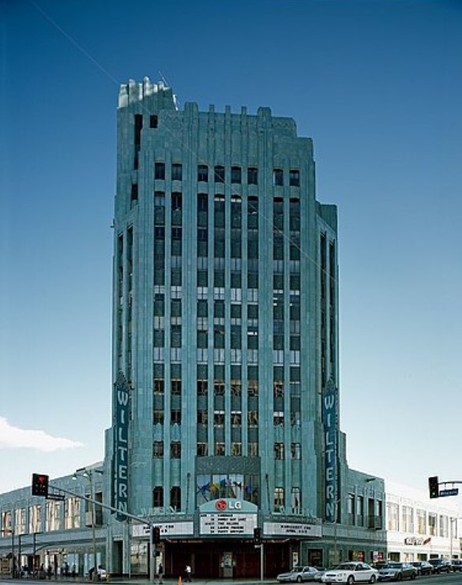
Northwest corner and both sides of Pellissier Building in 1977 photo (Tom Sitton for NRHP)
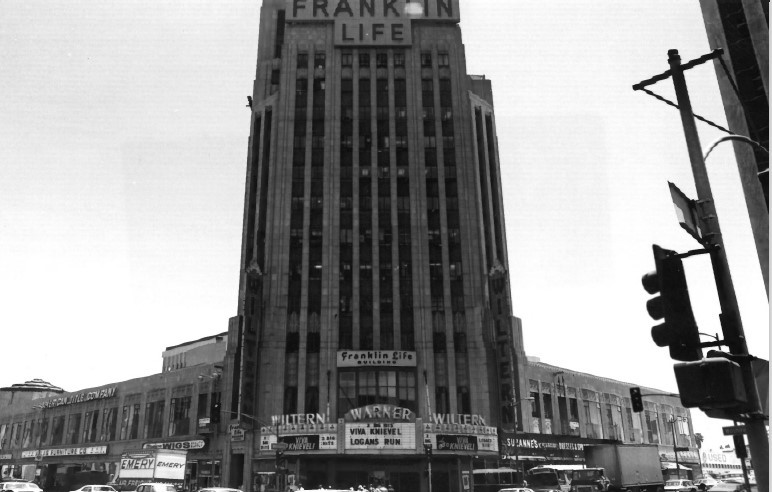
Interior view of the new theater from its balcony in 1931 photo (photographer unknown)
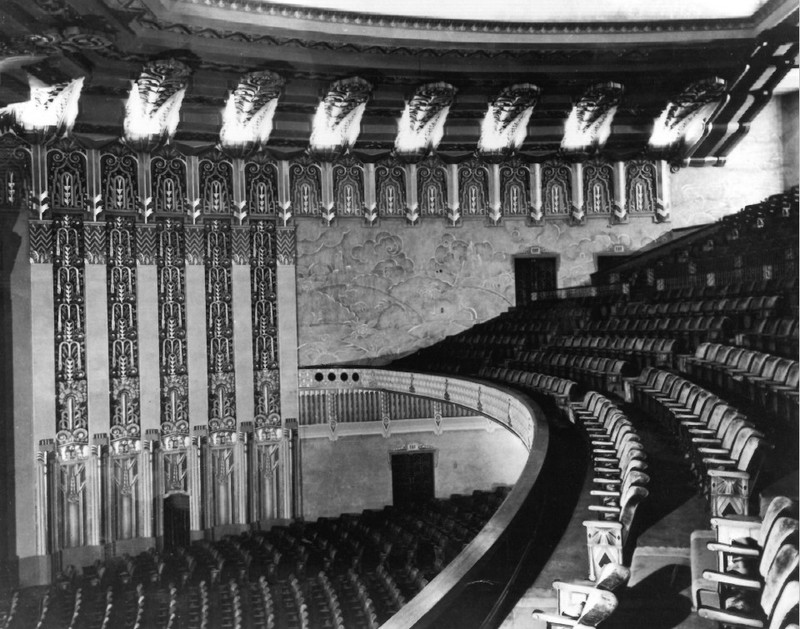
Detail of facade and Wiltern arrow sign in 2003 photo (geographer at en.wikipedia)
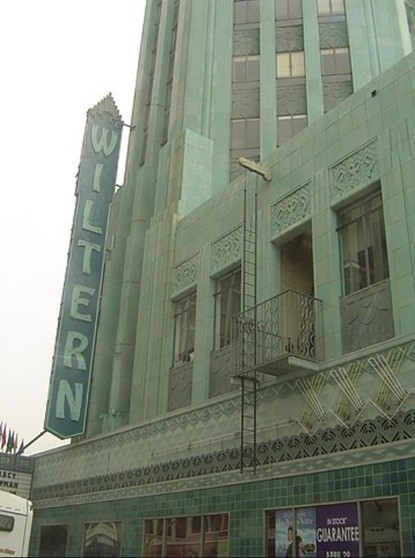
Clip of detail of north side of wing and tower in 1977 photo (Sitton)
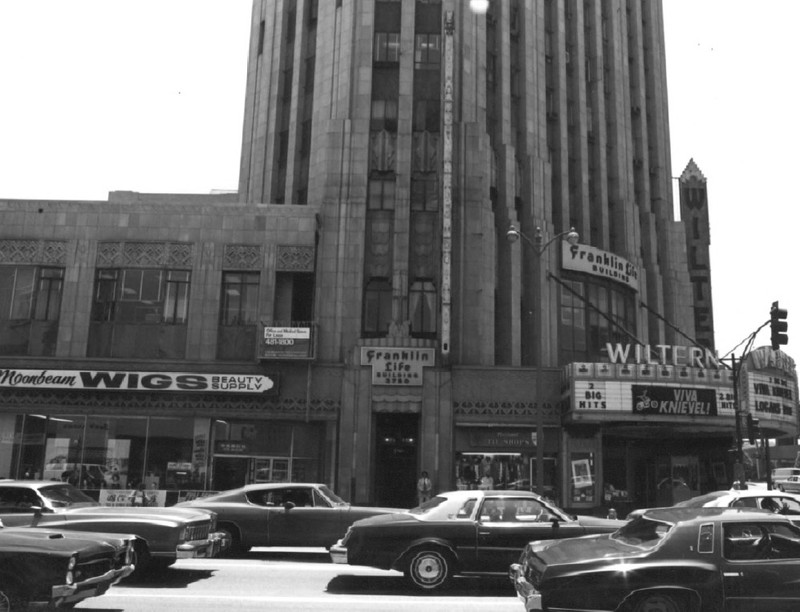
Backstory and Context
Text-to-speech Audio
Morgan, Wall & Clements designed the Art Deco office tower at 150 feet tall, the maximum allowed in Los Angeles in the early 1930s; buildings weren't allowed to be taller than City Hall. The strong vertical piers and narrow windows make the French Zig-zag Moderne building appear even taller. There are two-story wings on either side of the tower (along the streets) with commercial spaces on the ground floor. The building was constructed for real estate developer and socialite Henry de Roulet. Henry's mother's father, Germain Pellissier, a French immigrant, owned the land where the structure was built. The color of the exterior cladding of blue-green terra cotta over the reinforced concrete building came to be nicknamed Pellissier Green.
The Wiltern Theater in the base of the office tower got its name from the two streets at this intersection - Wilshire and Western Boulevards. Originally, it was known as Warner Brothers' Western Theater. A sunburst pattern of Art Deco skyscrapers decorated the 80-foot-tall ceiling was painted by noted muralist Anthony Heinsbergen Sr. and is just one of the fancy interior elements of the theater, designed by G. Albert Lansburgh. Opening night in October 1931 was attended by a who's who of Hollywood stars, including Clark Gable, Loretta Young, and James Cagney. The theater became a flagship location for the Warner Brothers movie theater chain. There was also a stage for live acts. The theater's organ was moved here from the Forum Theater, where it first was installed in 1924, and was claimed to be the largest organ in the U.S. West. Business at the theater was underwhelming, and Warner Brothers terminated their lease in 1933. The theater reopened in 1934 as an independent theater named the Wil-Tern. Warner Brothers came back to the building in 1939 and dubbed the theater Warner's Wiltern.
Franklin Life Insurance purchased the Pellissier Building in 1956 and remained in the "Franklin Life Building" until the office part of the building closed in 1979. The theater was transferred from the operation of Stanley Warner to Pacific Theaters in 1968. In 1973, the theater became a Los Angeles Historic-Cultural Monument. The Pellessier was threatened with demolition by Franklin Life in the late 1970s, after having the building up for sale since 1970. The theater remained open, showing movies until 1980. A combination of groups helped to save the building - the National Trust for Historic Preservation. the Los Angeles Conservancy, and Rick Newberger's Citizens' Committee to Save the Wiltern. Developers Ratkovich, Bowerts & Perez restored the building in a joint venture, spending about $9.8 million. The ceiling of the theater was restored in the early 1980s by Anthony Heinsbergen Jr., the son of the original artist. The rear wall of the stage was knocked out to provide for fifteen feet of additional depth. The grand reopening was held in 1985, with special guests Jack Warner, Jr., who had attended the 1931 grand opening with his father, and Alyce de Roulet Williamson (Henry's daughter).
The theater's lease was obtained by SFX in 2000 and Clear Channel in 2002. The company removed the theater's first-floor seating and installed five levels with a variety of configuration options. Clear Channel Entertainment is now Live Nation and continues to operate the Wiltern Theater. The Los Angeles Conservancy still holds a conservation easement on the building's exterior, ensuring the preservation of the theater marquee and twin blade "WILTERN" signs.
Sources
Hume, Mike. The Wiltern, Koreatown, Mike Hume's Historic Theater Photography. January 1st, 2023. Accessed May 17th, 2023. https://www.historictheatrephotos.com/Theatre/Wiltern-Los-Angeles.aspx.
Los Angeles Conservancy. The Wiltern & Pellissier Building, Explore L.A.. January 1st, 2020. Accessed May 17th, 2023. https://www.laconservancy.org/locations/wiltern-and-pellissier-building.
Gray, Pamela Lee. NRHP nomination of Pellissier Building, Los Angeles, California. National Register. Washington, DC. National Park Service, 1977.
https://en.wikipedia.org/wiki/File:Highsmithwilterntheater.jpg
National Park Service (NPS): https://npgallery.nps.gov/AssetDetail/NRIS/79000488
NPS: https://npgallery.nps.gov/AssetDetail/NRIS/79000488
https://en.wikipedia.org/wiki/Pellissier_Building_and_Wiltern_Theatre#/media/File:Wiltern_Theatre_Facade.jpg
NPS: https://npgallery.nps.gov/AssetDetail/NRIS/79000488
